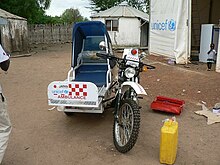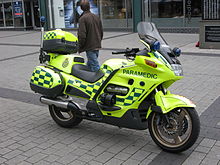Motorcycle ambulance

Motorcycle ambulances are a type of emergency vehicle which either carries a solo paramedic or first responder to a patient; or is used with a trailer or sidecar for transporting patients. A motorcycle ambulance is able to respond to a medical emergency much faster than a car or van in heavy traffic,[1][2][3] which can increase survival rates for patients suffering cardiac arrest.[4][5]
Worldwide motorcycle ambulances
Brazil

Since 2000, the São Paulo Fire Department has used motorcycle ambulances in a first responder role, to offset the influence of traffic on the response times of traditional ambulances. The motorcycles carry automated external defibrillators, splints, an oxygen supply and emergency delivery kits, among other first aid supplies.[6] Fire departments in other states, such as Minas Gerais, Mato Grosso do Sul and Pernambuco, have also adopted motorcycle ambulances since 2008.[7][8][9]
In August 2008, SAMU, the federal emergency medical services, purchased 400 motorcycle ambulances to be deployed nationwide between December 2008 and 2009.[10]
Japan
In some areas of Japan. Japanese fire departments use off-road motorcycles as emergency vehicles. They are useful for negotiating the small streets and heavy traffic in the large urban areas of Japanese cities. Having off-road motorcycles helps in responding to the mountain hills that are around a lot of cities. Some departments would likely have their crews in teams of two or three motorcycles. One of the motorcycles carries a first aid kit and/or automated external defibrillator. The other motorcycles in this team may carry fire fighting and rescue equipment. Most crews are firefighters with training in first responder, First Aid, and/or paramedic. Each crew member wears a light weight fire suit and a fire fighting motorcycle helmet. A lot of these motorcycles have their own radio, cargo bays, lights and sirens.
Kenya
As part of the United Kingdom's Department for International Development (DFID) wider £50 million country programme (2009), they are putting in place among other things a new motorcycle ambulance service. The Magunga's Health Centre now operates a motorcycle (sidecar) ambulance service.[11][12]
Malawi and Sudan

They have been used in remote rural areas in Malawi[13][14] and Sudan as a means to improve access to obstetric health care facilities for women in labor or needing prenatal care. Lightweight off-road motorcycles, equipped with a sidecar holding a stretcher for the patient, have been found to be an efficient supplement, but not replacement for, 4-wheel drive SUV ambulances. Purchase prices and operating costs have been found to be a fraction of a four-wheeled vehicle, and the sidecar rigs have been found to be less likely to be misused by diverting them for non-healthcare purposes. The lighter sidecar rigs are better able to cope with poor roads and areas that become impassible to heavier cars and trucks during the rainy season. Disadvantages include the reluctance of drivers to travel at night in some cases, and the inability to carry more than one patient at a time.[15][16]
The report concluded that:
Motorcycle ambulances reduce the delay in referring women with obstetric complications from remote rural health centers to the district hospital, particularly under circumstances where health centers have no access to other transport or means of communication to call for an ambulance. They are also a relatively cheap and effective option for referral of patients in developing countries, particularly in rural areas with little or no public transport. Nineteen motorcycle ambulances can be bought for the price of one Toyota land cruiser car ambulance. Operating costs compare in a similar way. Motorcycle ambulances also potentially help reduce costs for women and their families to access EmOC, although this was not the subject of this study.[17]
United Kingdom

Motorcycles are used as rapid response vehicles by emergency medical services in the United Kingdom.[18][19]
Manufacturers
Honda, BMW, and Yamaha motorcycles are common models used in many countries and departments. A number of manufacturers produce sidecars for motorcycles and scooters. Active motorcycle ambulance manufacturers include The Ranger Production Company,[20][21] and Riders for Health, a charity which manufactures the Uhuru in Zimbabwe.[22]
History


Motorcycle ambulances were used during World War I by the British, French and Americans. At the time the advantages of light weight, speed, and mobility over larger vehicles was cited as the motive for the use of sidedcar rigs in this role. The US version had two stretchers arranged one on top of the other.[23][24][25] The French ambulance used a sidecar that held a single patient, who could either lie down or sit up.[26]
The British Red Cross Society used an 8 bhp (6 kW) NUT motorcycle with a double decker sidecar like the US version. During testing it needed only a 9 ft (2.7 m) turning area, versus 35 ft (11 m) for a motor car ambulance, and had a lower fuel consumption of 55–65 mpg‑US (4.3–3.6 L/100 km), compared with 12–17 mpg‑US (20–14 L/100 km) for car ambulances. Due to lighter weight they were said to be less likely to get stuck and could be pushed out more easily than a large vehicle.[27]
Sidecar ambulances were used in Redondo Beach, California in 1915, stationed at a bath house at a beach resort to reach drowning victims quickly. Prior to using the motorcycle, life guards had to run or row up to several miles along the beach to respond to calls.[28] The Knightsbright Animal Hospital and Institute, London, was using a sidecar ambulance to transport dogs in 1912, and this mode was still in use in 1937 by the Maryland Humane Society.[29][30]

See also
References
- ^ Wood, Bill (April 1984), "Responding! Chicago's Fire Department finds out that two wheels can be better than four", American Motorcyclist, vol. 38, no. 4, American Motorcyclist Association, p. 19, ISSN 0277-9358, retrieved 2009-11-03
- ^ Sittamparam, R. (January 22, 2004), "M-cycle ambulance squad to start soon", New Straits Times-Management Times, p. 10, retrieved 2009-11-03
- ^ Staff Reporter (27 May 2009), "Motorbike ambulance service launched in Coimbatore", The Hindu ( Chennai ), retrieved 2009-11-03
- ^ Ong MEH, Chan YH, Anantharaman V. "Improved Response Times with Motorcycle Based Fast Response Paramedics in an Urban Setting" (pdf). SGH PROCEEDINGS, VOL 12, No 3, 2003. Singapore General Hospital Postgraduate Medical Institute. Retrieved 4 November 2009.
{{cite web}}: CS1 maint: multiple names: authors list (link) - ^ "Report from London Ambulance Service NHS Trust". Department of Health R&D Annual Reports 2007/08. London Ambulance Service. Retrieved 4 November 2009.
- ^ "Caos no trânsito muda trabalho dos bombeiros". G1 (in Portuguese). Globo.com. October 31, 2007. Retrieved 2009-11-07.
- ^ "Bombeiros adotam serviço de moto para agilizar resgate" (in Portuguese). Paraná Online. April 18, 2008. Retrieved 2009-11-07.
- ^ "Governo implantará atendimento do Corpo de Bombeiros com motos às vítimas" (in Portuguese). Notícias MS. June 30, 2009. Retrieved 2009-11-07.
- ^ "Corpo de Bombeiros implanta serviço de Moto Resgate" (in Portuguese). Governo do Estado de Pernambuco. November 10, 2008. Retrieved 2009-11-07.
- ^ Vaz, Lúcio (October 11, 2009). "Motos do Samu não estão sendo usadas para atender a população". Correio Braziliense (in Portuguese). Retrieved 2009-11-07.
- ^ "Improving Kenya's maternal care", newspaper, The Guardian, 2008, retrieved 2009-11-03
- ^ "Motorbikes and Midwives: Delivering Better Care for Kenya's Mums (press release)", Mobility and Health, International Forum for Rural Transport and Development (IFRTD), 8 May 2008, retrieved 2009-11-03
- ^ "Malawi launches Road Map to prevent women from dying while giving life", Office of the UN Resident Coordinator Malawi, 30 March 2007, retrieved 2009-11-1-
{{citation}}: Check date values in:|accessdate=(help) - ^ "Motorcycle ambulances in Malawi reduce maternal mortality", Mobility and Health, International Forum for Rural Transport and Development (IFRTD), 10 Dec 2007, retrieved 2009-11-03
- ^ IRIN (1 April 2009), SUDAN: Biking for safer childbirth; A motorbike ambulance is test driven in South Sudan at the launch of a pilot project aimed to cut maternal mortality, Integrated Regional Information Networks (UN Office for the Coordination of Humanitarian Affairs)
- ^ Kelly, Liz; Ford (13 May 2009), "Could motorbikes cut deaths in childbirth in Africa?", The Guardian
- ^ Dzimadzi, Chris; Lungu, Kingsley; Ratsma, Esther Y. (2008), "Motorcycle ambulances for referral of obstetric emergencies in rural Malawi: Do they reduce delay and what do they cost?" (pdf), International Journal of Gynecology & Obstetrics, 102 (2), International Federation of Gynecology and Obstetrics: 191–197, doi:10.1016
{{citation}}:|first1=missing|last1=(help);|first5=missing|last5=(help); Check|doi=value (help); Missing pipe in:|first1=(help); Missing pipe in:|first5=(help)CS1 maint: numeric names: authors list (link) - ^ "Motorcycle responder". London Ambulance Service. Retrieved 1 November 2009.
- ^ "Motorcycle Paramedics". Inside Out. BBC. February 2008. Retrieved 1 November 2009.
- ^ http://kambia.org.uk/new/what-we-do/our-projects/transportation-for-pregnant-women/
- ^ http://www.southafrica.info/business/trends/innovations/eranger.htm
- ^ George, Rose (6 December 2004). "Two wheels good". The Independent. Retrieved 4 November 2009.
- ^ Whitney, Caspar; Britt, Albert (October 1916-March 1917), Outing: sport, adventure, travel, fiction, vol. 69, Outing Publishing Company, p. 490
{{citation}}: Check date values in:|date=(help) - ^ Hopkins, Albert (1915), The Scientific American war book: the mechanism and technique of warfare, Scientific American, pp. 101–102
- ^ "Motorcycle Ambulance Has New Features", Popular mechanics magazine, vol. 30, Popular Mechanics, p. 165, 1918
{{citation}}: Unknown parameter|editorfirst=ignored (|editor-first=suggested) (help); Unknown parameter|editorlast=ignored (|editor-last=suggested) (help) - ^ "Chauffeur and Nurse, Too, is the Ambulance Driver", The Popular Science, vol. 93, no. 2, August 1918
{{citation}}: Text "ISSN 0161-7370" ignored (help) - ^ Buist, H. Massac (January 15, 1916), "Medical Arrangements of the Expeditionary Force", Motor Ambulances for War Service (Adobe PDF), p. 133
- ^ "Life Saving Motorcycle", Safety engineering, vol. 30, A. H. Best. Co., p. 270, 1915
- ^ "Motor Ambulance for Dogs", Popular Mechanics, vol. 18, no. 1–6, p. 570, July–December 1912
{{citation}}: Unknown parameter|editorfirst=ignored (|editor-first=suggested) (help); Unknown parameter|editorlast=ignored (|editor-last=suggested) (help)CS1 maint: date format (link) - ^ "Sick Dogs and Cats Ride Motorcycle Ambulance", Popular Mechanics, vol. 67, no. 2, p. 201, February 1937, ISSN 0032-4558
